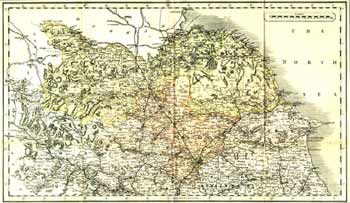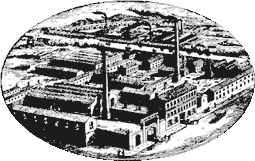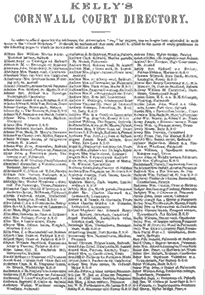Using Trade Directories in your Research by David Tippey
Trade Directories have been produced for well over 300 years and can prove to be an invaluable source of information about local communities. As well as information about individuals, they also provide a wealth of general background information. For the periods before the census was available, they provide a snapshot of communities and their principal inhabitants, and the later ones are extremely useful tools for locating ancestors in the census.
|
The Hampshire 1823 Pigot's Directory, Lincolnshire 1885 Kelly's Directory, Bulmer's Directory of North Yorkshire 1890, and Kelly's Cornwall Directory 1893 and many more Trade Directories are available on CD from www.GenealogySupplies.com.
|
The very first known directory of London merchants was published in 1677 and the Guildhall Library holds one of the major collections for the whole country, with London directories from 1736 onwards. The end of the 18th century saw the publication of the first national trade directory, with the unlikely title of Bailey's Northern Directory, published in 1781. However most of the examples that you will come across and find most useful, date from the 19th and early 20th centuries.
It was the great upsurge in trade brought about by the industrial revolution and the growth of the British Empire that boosted the publication of directories in the 19th century. County directories were published up to the Second World War and town directories continued to be published up to the 1970s, but with the widespread adoption of the telephone in the latter half of the 20th century, the original form of the trade directory disappeared to be replaced by the Telephone Directory and Yellow Pages. |
|
Outside of London, the early directories tended to cover large areas of the country, but as they grew in size these were then split into single County and large town or city volumes. They were published by many companies including; Pigot's; White's; Slater's and Baines, but it's the name Kelly's that most people recognise.
Frederic Festus Kelly became His Majesty's Inspector of Inland Letter Carriers and took over the production of the Post Office London Directory in 1835. By 1845, Kelly's had started to produce provincial directories that were eventually to cover every town and village. Many of these were still being printing until the early 1970s, still arranged in more or less the original format. The Post Office London Directory managed to keep going the longest, finally ceasing publication in 1991, and an internet business directory still carries the Kelly name today. |
|
As printed directories are only intended to have a life of a few years, they were cheaply produced and the out of date ones would be discarded. In consequence they are relatively rare and expensive. With few copies in circulation, they are generally only to be found in the reference libraries and local archives of the areas they covered. This has meant that they were difficult to consult unless you lived in or visited the area of your research. The current trend to republish many of the early directories on CD has made this useful resource easily accessible to many more family historians.
Below: Map of North Yorkshire from Bulmer's Directory of North Yorkshire 1890

The format of the directories was established with the first 18th Century publications and remained fairly standard until the 20th century.
Entries for a town usually start with a topographical account and often an historical preamble. They may well describe the local industries and include details of the local markets and transport facilities as well. Directories can provide a wealth of background information about an area, and you can find descriptions of churches, schools, charities, lists of people involved in local government, population statistics, details of local newspapers, advertising and sometimes maps too. Directories produced in the 20th century have often lost the historical and topographical content in favour of advertising, which was even added to the outside covers and the page edges.
The general introduction to each town is then followed by listings of the local worthies - landowners and gentry; clergy; doctors and lawyers and possibly their widows. Only then do you get the lists of people in trade. Unless your ancestors fit into one of these categories their names are unlikely to appear in the early directories, as they don't include any labourers, servants, shop assistants, clerks or other employees. As you move through the 19th century however, directories start to include street directories and surname listings for heads of households and so gradually included a much wider section of the population who weren't "principle inhabitants" or trades people.
 Villages and hamlets had scant coverage in early directories, often receiving only a brief mention with one or two names, attached to the entry for the nearest sizeable town. The Universal British Directory of 1791 contains only 8 entries for the nine townships comprising the parish of Kirkby Malhamdale, despite the parish records showing plenty of trades people. However by the end of the 19th century many directories contained not only extensive listings of the professional and trades people, but also listed the heads of households, often with their professions, ordered into both street and surname indexes. Villages and hamlets had scant coverage in early directories, often receiving only a brief mention with one or two names, attached to the entry for the nearest sizeable town. The Universal British Directory of 1791 contains only 8 entries for the nine townships comprising the parish of Kirkby Malhamdale, despite the parish records showing plenty of trades people. However by the end of the 19th century many directories contained not only extensive listings of the professional and trades people, but also listed the heads of households, often with their professions, ordered into both street and surname indexes.
Trade directories were not always accurate or complete, so always try to corroborate the information you find. There are errors and spelling mistakes and new editions were sometimes based on old ones or even other publications. Some people would not want to be included, and it's not clear, especially with the early directories, whether or not you would have to be a subscriber to be included in the listings.
Below: A page from Kelly's Cornwall Directory 1893
 A few copies of directories were available as fiche, but once PCs, scanners and CD writers became relatively cheap and common, the range of directories available to the home researcher blossomed. Most publications are scanned and prepared as Adobe Acrobat files, a cross platform format that allows the scanned images to be viewed on virtually any computer. Some are just supplied as bitmap image files, but these are not as easy to use. Acrobat is a more elegant solution and allows the author to provide links and bookmarks to make navigation easier. A few copies of directories were available as fiche, but once PCs, scanners and CD writers became relatively cheap and common, the range of directories available to the home researcher blossomed. Most publications are scanned and prepared as Adobe Acrobat files, a cross platform format that allows the scanned images to be viewed on virtually any computer. Some are just supplied as bitmap image files, but these are not as easy to use. Acrobat is a more elegant solution and allows the author to provide links and bookmarks to make navigation easier.
Some republished directories make use of the Acrobat search function to find entries. However this is based on a background OCR version of the text that cannot be edited. As anyone who has used OCR knows, it isn't perfect, and works much better on the later publications with good print quality. So if you don't find what you are looking for with the electronic search facility, don't give up, try again, using it just like you would the original book. Finding likely ancestors in a directory is a great help in finding them in the census, where much more comprehensive information about the household can be found. For that reason it's a good idea to search directories that are available close to the census years. Even if they have moved, it provides an area to base a search on and you may find other relatives still living nearby. Identifying the area they lived in, especially in a large area of population, will also help to identify likely churches whose records you can search for family events. The directory entries will also provide you with lost of local information that help you add some meat to the bones of your research, so they are well worth seeking out.
|